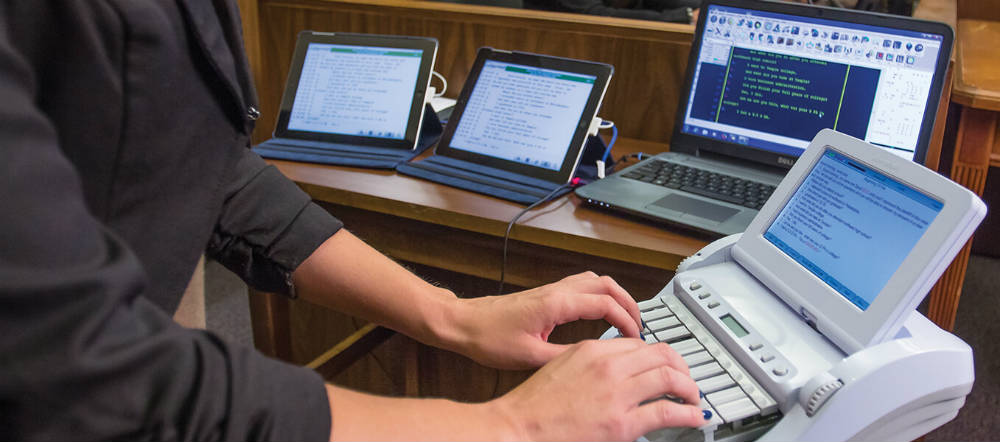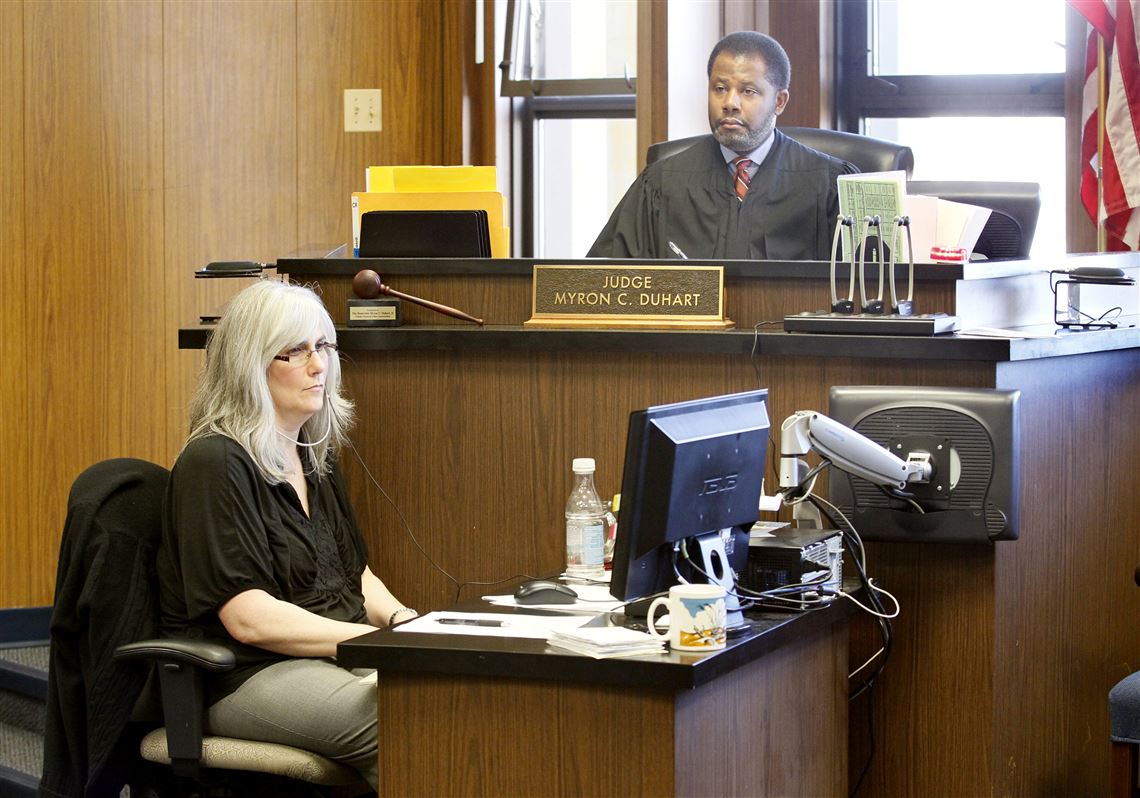All About Court Reporting: Crucial Insights Into Its Relevance in Regulation
Court reporting serves an essential function within the lawful framework, supplying a accurate and trusted record of procedures. Through sophisticated strategies and tools, stenotype reporter capture the nuances of testaments and legal dialogue. The relevance of their work prolongs past plain transcription. As the legal landscape advances, so too does the duty of technology in court reporting. Comprehending these characteristics exposes much deeper implications for justice and openness in the legal system.
The Function of Court Reporters in the Legal System

Commonly forgotten, court press reporters play an essential function in the lawful system by making certain a accurate and verbatim document of proceedings. Their main obligation entails recording spoken words during trials, depositions, and other legal events, which acts as an official record for future recommendation. This documents is necessary for allures, as it gives the necessary details for evaluating choices made by juries and judges.
Stenotype reporter must have remarkable listening abilities and a deep understanding of lawful terminology to catch the nuances of testimony and argumentation properly. Their job contributes to transparency within the judicial procedure, enabling responsibility and fairness. In addition, they assist in access to justice by making documents readily available to included parties, making certain that everybody has the chance to review the process. This way, court press reporters maintain the integrity of the lawful system, strengthening the importance of precise communication in issues of law.
Devices and methods Used in Court Reporting
In court reporting, different techniques and devices enhance the precision and efficiency of transcription. Stenography modern technology plays a substantial role, permitting press reporters to capture talked words quickly, while electronic recording approaches provide alternative options for documentation. Recognizing these tools is essential for comprehending how court press reporters fulfill their essential feature in the lawful system.
Stenography Innovation Review
Stenography innovation functions as the foundation of modern-day court reporting, allowing reliable and accurate transcription of talked dialogue. Making use of specialized devices understood as stenographs, court reporters can record speech at remarkable rates, usually surpassing 200 words per min. These equipments employ an one-of-a-kind keyboard format that enables numerous keys to be pressed all at once, creating phonetic depictions of words - durham court reporting. This method lessens the need for substantial punctuation and enhances transcription accuracy. Furthermore, clerks utilize different shorthand methods and signs to more improve the process, guaranteeing that no detail is ignored throughout process. The integration of stenography innovation not just promotes efficient interaction in legal settings but also supports the integrity of the judicial process by offering trusted and accurate records of discussions
Digital Recording Approaches
A raising variety of court reporting experts are turning to digital recording approaches to boost the accuracy and efficiency of their transcriptions. These techniques make use of sophisticated audio and video clip modern technology to catch proceedings in real-time. Digital recorders, frequently paired with high-quality microphones, assure that every word spoken is preserved with quality. Additionally, specialized software application can transcribe audio documents immediately, enabling quicker turn-around times. Some specialists integrate dual recording systems for redundancy, ensuring no vital information is shed. On top of that, electronic recordings can be easily indexed and looked, assisting in swift access of particular sectors. As legal settings develop, welcoming these digital devices not only simplifies the reporting process yet additionally preserves the honesty of the record.
The Importance of Accuracy in Transcription
Accuracy in transcription is essential in court reporting, as it assures that legal documents show the true material of proceedings. This accuracy can considerably influence instance results, influencing the decisions made by courts and judges. As a result, preserving high criteria of accuracy is extremely important in the lawful occupation.
Precision in Legal Records
The legal system counts heavily on eloquent disagreements and influential unsupported claims, the true backbone of judicial procedures exists in the accuracy of lawful records. Precise transcription is crucial, as it guarantees that every concern, judgment, and statement is recorded appropriately. Such precision offers numerous objectives, consisting of offering a reliable reference for allure procedures and maintaining the integrity of the judicial system. Errors in transcription can result in misconceptions, misinterpretations, and potentially damaging repercussions for all events entailed. Court reporters must have phenomenal abilities and attention to detail, as their work directly influences the quality of lawful records. Inevitably, the accuracy of legal records underpins the depend on placed in the judicial procedure, enhancing the value of thorough transcription.

Influence On Instance Outcomes
When lawful proceedings unravel, the accuracy of transcription commonly dictates the trajectory of a case's end result. Exact court reporting assurances that every word spoken is efficiently captured, making it possible for attorneys, courts, and juries to make educated choices based upon the record. Mistakes in transcription can result in misconceptions, false impressions, and potentially unjustified decisions. The integrity of lawful documents counts heavily on the precision of these records, as they function as the structure for appeals and more legal activities. In high-stakes cases, where the effects are profound, the duty of a stenotype reporter comes to be much more vital. Preserving rigorous requirements in transcription not just supports the lawful process yet likewise upholds the principles of justice and justness in the court room.
Court Reporting in Different Legal Setups
Court reporting plays an essential duty throughout numerous lawful settings, making sure that procedures are accurately recorded for future recommendation. In criminal court, stenotype reporter record statements, evidence, and judicial judgments, which are critical for allures and situation evaluations. In civil lawsuits, accurate records promote the discovery process and supply a reliable document for test process. Management hearings commonly count on court press reporters to keep a main document, ensuring transparency and accountability in governmental procedures. Family members courts also gain from court reporting, as accurate documentation of proceedings can affect custodianship choices and settlements. Furthermore, depositions in pre-trial phases need exact recordings to capture the nuances of witness testaments, which might be considerable fit case strategies. Overall, court reporting serves as a keystone in the lawful system, cultivating justness and clearness across diverse judicial environments.
The Influence of Modern Technology on Court Reporting
As innovation remains to develop, its influence on court reporting has become increasingly significant. Innovations such as digital recording, real-time transcription software, and fabricated knowledge have transformed traditional techniques. Digital audio recorders currently record official statement court room procedures with informative post remarkable quality, enabling stenotype reporter to concentrate on nuances and context as opposed to exclusively on inputting. Real-time transcription technologies make it possible for instant access to records, promoting effectiveness and enhancing cooperation amongst lawyers. Furthermore, expert system tools are being incorporated to help in the transcription process, minimizing human error and expediting paper generation. Despite these innovations, the crucial abilities of court press reporters remain invaluable, as they give a nuanced understanding of legal language and court room characteristics. Eventually, innovation enhances as opposed to changes the know-how of court reporters, making sure that the honesty and accuracy of lawful documents are supported in an increasingly digital landscape.
Occupation Opportunities and Pathways in Court Reporting
The development of modern technology in court reporting has actually opened up a variety of profession chances for aiming specialists in the field. Typically, stenotype reporter were mostly liable for recording lawful proceedings. However, developments such as digital recording and real-time reporting have broadened their functions.
Today, court reporters can focus on areas such as captioning for transmission, offering transcription services for legal firms, and working in the corporate industry for meetings or depositions - durham court reporting. In addition, possibilities in remote reporting, specifically as a result of the surge of digital court rooms, have actually come to be increasingly prevalent
Educational paths consist of formal training programs, accreditation courses, and continuing education to remain upgraded with technical modifications. Networking within expert and lawful organizations also plays a significant duty in job advancement. Overall, the varied opportunities in court reporting reflect the dynamic nature of the legal occupation and the increasing demand for competent professionals.
The Future of Court Reporting in an Evolving Legal Landscape
How will the role of court reporting adjust as the lawful landscape continues to evolve? As modern technology advances, court reporting is most likely to welcome cutting-edge tools such as synthetic intelligence and real-time transcription software program. These innovations might improve accuracy and efficiency in capturing lawful procedures. Furthermore, the increasing frequency of remote hearings necessitates that court reporters end up being skilled see page in electronic systems, guaranteeing seamless paperwork no matter of location.
At the same time, stenotype reporter will certainly need to adapt their abilities to take care of new sorts of situations, such as those entailing cyber law and copyright conflicts, which need specialized expertise. Additionally, the demand for immediate accessibility to records will certainly press professionals to deliver quicker turnaround times without jeopardizing top quality. Inevitably, the future of court reporting will certainly hinge on a balance between standard abilities and technical integration, guaranteeing that the stability of the lawful procedure stays undamaged in an increasingly digital world.
Frequently Asked Questions
Just How Do Court Press Reporters Take Care Of Delicate Details Throughout Procedures?

What Credentials Are Needed to Become a Stenotype Reporter?
To come to be a stenotype reporter, people usually need a senior high school diploma, specialized training from an accredited program, effectiveness in shorthand or voice writing, and accreditation or licensure, depending on state needs and guidelines.
Are Court Reporters Required to Have a License?
Stenotype reporter are commonly required to obtain a certificate, depending upon the territory. Licensing assurances that they meet details requirements of effectiveness and professionalism and trust, which is vital for maintaining the stability of legal procedures.
How Do Court Press Reporters Manage Various Accents and Dialects?
Court press reporters manage various accents and dialects via considerable training, method, and knowledge with various speech patterns. They commonly utilize specialized software and methods to precisely catch talked words, making sure quality and precision in their records.
What Is the Ordinary Salary for a Court Press reporter?
The ordinary salary for a stenotype reporter differs by area and experience, usually varying from $50,000 to $80,000 annually. In high-demand areas, incomes can go beyond $100,000, mirroring the profession's value and specialized abilities.
Frequently ignored, court press reporters play an essential function in the lawful system by making sure a verbatim and accurate record of proceedings. In criminal court, court reporters transcribe statements, proof, and judicial judgments, which are critical for appeals and case reviews. Family courts likewise benefit from court reporting, as precise paperwork of procedures can affect wardship choices and negotiations. Commonly, court press reporters were primarily liable for recording lawful process. Today, court press reporters can specialize in locations such as captioning for tv programs, supplying transcription services for legal firms, and working in the company field for conferences or depositions.